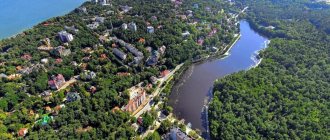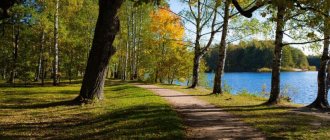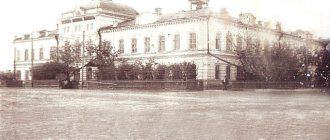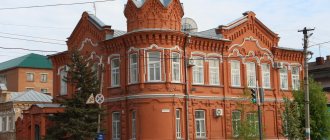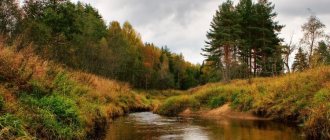Sestroretsk is a city in Russia, a municipal entity within the Kurortny district of the federal city of St. Petersburg. A seaside climatic balneological mud resort with its own mineral water and healing mud on the northern shore of the Gulf of Finland of the Baltic Sea.
Located in the south of the Karelian Isthmus. Several watercourses flow through the city, connecting Lake Sestroretsky Razliv and the bay (Sestra River, Gagarinsky Stream, the so-called Rusty Ditch). The historical districts of Gorskaya, Aleksandrovskaya, Tarkhovka, Razliv, Kurort and Duny are located on the territory of the city.
Railway stations Sestroretsk, Gorskaya, Aleksandrovskaya, Tarkhovka, Razliv and Kurort on the line St. Petersburg (Finlyandsky Station) - Beloostrov. The distance from the main station of the city (Sestroretsk) to the Finlyandsky station of St. Petersburg is 34 kilometers.
Resort factors
Clean ionized sea air, air saturated with pine aroma, pine forests, sea bathing, sandy beaches are favorable for climatic and thalassotherapy for diseases of the circulatory, respiratory, and nervous system. Coniferous forests, sand hills and dunes create a natural barrier to the winds and provide shade, which allows helio- and aerotherapy to be carried out on the beaches. The deep heating of sand in the dune area makes it possible to conduct sand baths. The gently sloping seabed forms sandy shallow waters of several tens and even hundreds of meters, convenient for children to swim in. The swimming season is from mid-June to the end of August (average water temperature in July is +19.3 °C). Along with this, sapropel mud is used for treatment - the so-called gyttiya, used at the resort for mud therapy. The deposit is located in the western part of the swamp adjacent to Lake Sestroretsky Razliv (mud reserves over 1 million tons). Mineral water is sodium chloride in composition with a mineralization of 1.12 g/liter and radon content (7 nCi/l). Daily flow rate is 400 cubic meters. Used for balneotherapy (drinking treatment, baths).
Pros of living in the city of Sestroretsk St. Petersburg
Sestroretsk is a city for those who value peace, tranquility and clean air.
Ecological situation
It’s not for nothing that the resort area got its name: there is a truly healing atmosphere here, the proximity of the bay and pine forests create a unique microclimate that will suit everyone who closely monitors their health. This area is recommended primarily for families with small children and elderly relatives.
Sanatoriums
Within walking distance of Sestroretsk there are a large number of sanatorium and resort complexes, most of which are quite accessible and offer an extensive treatment and rehabilitation program.
Sports and active recreation
The city of Sestroretsk is home to many different sports complexes and educational institutions. Classes and competitions are held in golf, equestrian sports, paintball, and the “Sestroretsk Rally” is also regularly organized. Therefore, the area is perfect for lovers of active recreation who cannot imagine their life without sports and movement.
Peace of mind and safety
The crime situation in the city is extremely favorable: Sestroretsk in St. Petersburg ranks last in terms of the number of crimes. Most often, incidents occur in the summer, at the height of the holiday season, but this is due solely to the negative behavior of some visitors.
Story
The territory of the city in the Stone Age
About 3000-3500 years ago, prehistoric man appeared at the mouth of the Sestra River. This is evidenced by archaeological finds in the bases of the dunes near the western shore of Lake Sestroretsky Razliv, first discovered in 1905. Now in this area, eleven sites of ancient man from the Neolithic (New Stone Age) have been found. The inventory of the sites is represented by tools made of quartz - arrowheads, scrapers for processing hides. There are many shards of ancient pottery decorated with pit-comb ornaments, characteristic of the Neolithic tribes who lived in the 3rd-2nd millennia BC throughout the forest belt of Eastern Europe. Remains of hearths (burnt stones and ash) are found next to broken dishes. Scientists believe that these sites belonged to wandering communities of hunters. They did not know agriculture and did not have domestic animals.
Russo-Swedish wars
The coast of the Gulf of Finland has more than once become the object of military conflicts between the Russians and the Swedes. The first document that established the border in this region was the Treaty of Orekhovo in 1323, concluded by the Novgorod prince Yuri Daniilovich and the Norwegian-Swedish king Magnus. According to it, the border of the Novgorod Republic with the Kingdom of Sweden was established along the Sestra River. Contrary to the text of the document, this peace did not become “eternal”, and later, as a result of the Russian-Swedish war of 1614-1617, the Stolbovo Peace was concluded, according to which Russia was completely deprived of access to the Baltic Sea.
The first mention of the trading settlement-fair Systerbäck at the mouth of the Sestra River is found in the Swedish chronicles of 1643.
As a result of the Northern War, Peter I managed to recapture these lands, including the mouth of the Sestra River. Here in May 1703, Russian troops defeated the twelve thousand army of the Swedish general Kroniort.
The emergence of the city
To gain a foothold on these lands, a harbor was built in 1706 near the mouth of the Sestra River. In 1710, an expedition was sent to these places with the goal of finding iron ores and drawing up a map of the area.
The new history begins with Peter I's visit to the Sestra River on September 20, 1714. The Emperor ordered the construction of a summer palace on the shore of the Gulf of Finland, and a garden nearby. The palace was built in 1719-1724 from locally produced bricks (later it would have been dismantled in 1781). About 2,000 young oak trees were planted near this palace. A few years later they decided to build a dam on the Sestra River. The dam began to be used for a different purpose, as the long Northern War created a need for increased weapons production. In June 1721, the construction of an arms factory began under the leadership of the commander of the Olonets factories, Colonel Wilhelm Gennin. In 1723, he was sent to Siberian factories, and work at the Sestroretsk arms factory was completed by Colonel Matvey Vyrubov. After the construction of the dam on the Sestra River, a vast reservoir was formed - Sestroretsky Razliv. On January 27, 1724, the plant was opened. The plant provided the army with pistols, muskets and cannons, and also produced civilian items (hinges, door handles, copper buttons necessary for a uniform), gratings for the Fontanka River, the Catherine Canal. The plant also operated 15 gunpowder workshops (in 1740, their equipment was transferred to the Okhtinsky gunpowder factories). Sestroretsk craftsmen made the famous “Papin’s car” based on the drawings of M.V. Lomonosov, as well as a silver shrine intended for the relics of Alexander Nevsky.
In 1721, simultaneously with the construction of the arms factory, a wooden Peter and Paul Church was erected on its territory; after the fire of 1730, it was rebuilt in another place.
In 1735, on the Dibun-swamp, near the Aspen Grove manor, the Chernorechensky iron foundry was built, smelting metal from local ore. He gave his first melt in the fall of the same year and continued to supply the Sestroretsk arms factory with raw materials for more than fifty years.
During the Russian-Swedish war of 1741-1743, fortifications were built in Sestroretsk. The earthen fortifications were renovated during the Crimean War of 1853-1856, and in June 1855 the city withstood bombardment by the Anglo-French fleet.
In 1809, the Grand Duchy of Finland was formed as part of the Russian Empire, and in 1811 the Vyborg province along with Sestroretsk was included in it, after which the border of Finland with the St. Petersburg province passed along the Sestra River.
In 1847, a horse-drawn railway line was laid from the Dubkovskaya pier on the coast of the Gulf of Finland to the Arms Factory. From June 1849 to September 1852, Ivan Ovsov and Dmitry Zubov, in agreement with the department of military settlements, built a highway from Dubkovskaya pier to the front entrance of the plant with a length of 1410 linear fathoms (about 3 km). On September 21, 1853, as a result of a strong hurricane caused by waves of the Gulf of Finland, the road was destroyed.
By personal decree of Emperor Alexander II dated February 1 (14), 1864, the plant and the adjacent territory were separated from the Vyborg province and annexed to the St. Petersburg province. It was promised that in return Finland would be given “or the coastal strip near the Arctic Sea west of the river. Jacobs-Elf [means Vorem and then Pechenga], <…> or, according to proper allocation and assessment, free lands of the St. Petersburg province located along the border.”
On July 15, 1868, a major fire broke out, destroying about 800 houses and a cemetery. No more than 50 houses survived in the village.
On July 12 (24), 1871, in the city center (now Freedom Square), a new stone Peter and Paul Church was laid, built according to the design of the architect G. I. Karpov. Its solemn consecration was performed on June 9 (21), 1874 by Metropolitan Isidore (Nikolsky) of Novgorod, St. Petersburg and Finland.
On November 2, 1871, traffic opened on the Beloostrov-Sestroretsk railway line, 6 miles long. But due to unprofitability, from January 1, 1886, traffic along it was completely stopped. At the end of the 1880s, the question of building a horse-drawn railway from Staraya Derevnya along the existing dirt road was considered, but in the end it was decided to build a steam-powered road.
On July 23, 1893, the first section of the new Primorskaya Railway was opened from Novaya Derevnya to Ozerki, on July 12, 1894, the road was extended to Lakhta, on October 31 of the same year - to Razdelnaya (now Lisiy Nos station), and on November 26 - to Sestroretsk.
In 1889, engineer Pyotr Aleksandrovich Avenarius became the chairman of the newly created Joint Stock Company of the Primorskaya Petersburg-Sestroretsk Railway. In the village of Tarkhovka, Avenarius is building an estate for better management of the joint-stock company and construction. In 1894 the road came into operation.
Prices for travel and luggage, as well as the need to maintain the pier in Lisem Nosu, made the company's work unprofitable. For the purpose of economic development, P. A. Avenarius asked the government to allocate a plot of land on the shore of the Gulf of Finland at the mouth of the Sestra River for the construction of a Resort, which was in accordance with the charter of the society.
Sanatorium "Sestroretsky Resort"
On June 9, 1898, the Cabinet of Ministers authorized the construction of the Resort, allocating 54 acres for free rent for a period of 60 years and an obligation to build the Sestroretsk-Resort railway.
On June 10, 1900, the Sestroretsky Resort sanatorium was opened. Around the sanatorium there was intensive development of land for dacha and sanatorium development. The village of Dunes appeared on the banks of the Rusty Ditch. The railway was extended from the station. Resort to Duny village (Shkolnaya station, Duny station). At the end of the railway, with the assistance of P. A. Avenarius, the Dune Church of Christ the Savior was built. Pyotr Alexandrovich was buried near this church on December 4, 1909.
Subsequently, the church found itself on the front line of the Second World War and was destroyed, along with the graves. In the 1970s, for some time it was still possible to see the remains of the foundation of the church and the broken pedestal for the grave cross, on which one could read the inscription: “To the creator of this temple, the transformer of the wilderness into the Sestroretsk Resort P. A. Avenarius.” The fragments of the monument to P. A. Avenarius were kept for some time in the local history museum of school No. 434 in the village of Razliv, and later transferred to the Sestroretsky resort sanatorium.
After the construction of the Primorskaya Railway, Sestroretsk became the largest recreation center on the entire coast of the Gulf of Finland. In 1898, the joint-stock company of the Primorskaya Railway founded one of the first sanatoriums in the north-west of Russia, the Sestroretsky Resort, in a forest park on the shore of the bay. In 1903, the resort received the highest award at the international exhibition at Spa in Belgium.
The electrification of Sestroretsk began on October 2, 1896, when a power plant was launched, which provided electricity to illuminate the factory premises (it worked until mid-1897). The second power plant was built in 1899, the energy it generated was also used to illuminate the plant’s workshops, but since 1901, when new dynamos were added, electricity was already supplied not only to the plant, but also to other facilities. By 1903, 1954 incandescent lamps had already been installed in Sestroretsk (including 298 in private apartments) and 131 lanterns operating on the principle of a voltaic arc; Electric lighting was used at the factory, Tsemyannaya Street, Dubkovskoe Highway, in the courtyards of factory buildings, the infirmary, the barracks of the military artillery team and some private apartments. In 1908, a private power plant of the merchant Olaf was built in a swamp near the plant, and in April 1913, electricity began to flow to Sestroretsk via a line from a substation in Staraya Derevnya, owned by the Russian Electric Lighting Society.
From 1894 to 1902, master gunsmith Sergei Ivanovich Mosin, the author of the famous three-line rifle of the 1891 model, was the head of the Sestroretsk plant. During the First World War, the plant operated at full capacity.
In July-August 1917, on Lake Sestroretsky Razliv, V.I. Lenin and G.E. Zinoviev hid in a hut from persecution by the Provisional Government.
Soviet period
In 1918-1940, the state border with Finland passed 2 km north of the city.
Since 1922, the Sestroretsk plant has turned into a tool factory.
In 1923, by order of the People's Commissar of Health N.A. Semashko, the Sestroretsky Resort was designated as cardiological in terms of its health profile. In 1924, the physiotherapy department was partially restored here and the laboratory was expanded, physical therapy was widely used in treatment, dental and X-ray rooms, a dressing room, a pharmacy, and a clinic operated. In just three months of 1924, the sanatorium received 1,435 patients. In 1937, the sanatorium was transferred to the military department.
By a resolution of the Presidium of the All-Russian Central Executive Committee of June 16, 1925, the villages of Duny, Ermolovskaya, Kurort, Razliv, Tarkhovka and Aleksandrovskaya were annexed to Sestroretsk, and it itself received the status of a city.
On July 15, 1928, according to the project of architect A. I. Gegello, the granite monument “Shalash” was opened.
In 1931, the Peter and Paul Cathedral was closed and dismantled in 1932-1933. A school building was built in its place.
During the Great Patriotic War, the front line was located near Sestroretsk. In September 1941, the advance of Finnish troops was stopped on the approaches to Sestroretsk. The border of resistance ran along the Rusty Ditch at the 39th kilometer of the Primorskoye Highway, here the tank breakthrough of the Finnish army was stopped and the line of the Sestroretsk defense passed here. From this line in June 1944, Soviet troops launched a counteroffensive.
During the Great Patriotic War, the wooden Kursaal of the Sestroretsk Resort was completely destroyed. In 1954, after a major renovation, the medical complex of the sanatorium opened. In the 1960-1980s, massive housing construction was carried out in Sestroretsk, mainly multi-storey buildings.
In 1969, a new mud bath at the Sestroretsk Resort was built. In 1978, a 10-story building with more than 500 seats was built. The building also houses a dance hall, a conference room, and a library.
Modern period
In 2000, a monument to Peter I by sculptor V. A. Petrov and architect V. S. Vasilyev was erected in Sestroretsk. In 2001, a monument to the Russian designer and organizer of small arms production S.I. Mosin was unveiled (sculptor B.A. Petrov, architect A.G. Bakusov).
In 2001, after a major renovation, the only swimming pool with mineral water in St. Petersburg opened in the Sestroretsky Resort sanatorium. In 2008, at the All-Russian forum “Zdravnitsa-2008”, the sanatorium became the winner in the category “Best Balneotherapy Hospital”.
On June 14, 2004, the ceremonial foundation stone of the Church of Saints Peter and Paul, Equal-to-the-Apostles, was held at the new location. The new temple was erected in memory of Russian submariners. The ceremonial consecration was performed on October 11, 2009 by Patriarch Kirill of Moscow and All Rus' in the presence of the Minister of Defense of the Russian Federation and the Commander-in-Chief of the Navy.
In December 2004, with grants from Sweden and Finland, the reconstruction of sewage treatment facilities in Sestroretsk was completed. During wastewater treatment, nitrogen and phosphorus are removed without reagents, which will significantly reduce the load on the Baltic ecosystem. Another innovation was the disinfection of sewage wastewater with ultraviolet light before discharging it into a reservoir.
By decree of the government of St. Petersburg dated February 15, 2011, the state nature reserve “Sestroretskoe Bog” was established on the territory of Sestroretsk, as well as the villages of Beloostrov and Pesochny.
City name
The first mention of the trading settlement-fair Systerbäck (Swedish: Systerbäck) at the mouth of the Sestra River is found in the Swedish chronicles of 1643. The name of the city is based on the hydronym Sister (from the Finnish Siestarjoki - “blackcurrant river”). The Finnish (Siestarjoki) and Swedish (Systerbäck) forms of the city's name still coincide with the name of the river.
Architecture and landmarks
Park "Dubki"
On a cape protruding into the Gulf of Finland there are the Sestroretsk “Oaks” (1719, architect S. van Zwieten, garden master O. Udelfelt) - a park with a Dutch garden, hydraulic structures and a defensive rampart.
At the beginning of the 18th century, one of the country residences of Peter I was located here. By 1722, a three-story stone palace was built on a long sand spit, connected by galleries with wooden pavilions; orchards and a large pond adjoined the palace. During the Russian-Swedish war of 1741-1743, fortification ramparts were built in Dubki to protect against possible landings. A strong storm in 1743 damaged the harbor structures and the palace, which was dismantled in 1782 for economic needs. The fortress ramparts were used during the Crimean War - June 14, 1855, when the combined Anglo-French fleet fired at Sestroretsk for several hours, but did not dare to land.
The park has a landscaped recreation area.
Other attractions
- Destroyed tuberculosis hospital - next to Razliv station. It was built at the end of the 19th century, and there was a charity house there before the revolution. Then the building was converted to treat open forms of tuberculosis. In 1980, the hospital was closed due to a decrease in the number of tuberculosis patients. The film “Purgatory” was filmed on the ruins of this hospital. The complex was demolished in 2010. In its place, the residential “House at Razliv” is being built. The park was also completely cut down and the historical appearance of the Razliv railway station was ruined.
- The mansion in Sestroretsk (20th century, Grigorieva Street, 4) is a wooden mansion. Demolished in 2014.
- The Sestroretsk gazebo is a wooden gazebo that was for many years a calling card, a symbol of the city, but is now in ruins. Now on Tokarev Street, near house No. 1, an exact copy of the gazebo has been installed.
- The dacha of E. F. Vazhevskaya (1907, Andreeva Street, 12) is a wooden dacha in the traditions of Russian folk architecture with elements of modernism. As of 2014, it is in ruins.
- Dacha of Ya. M. Goldenov (1908, architect S. G. Ginger, M. Gorky Avenue, 20). It was demolished in 2010, and a similar new building was built by 2014.
- Klyachko's dacha (1908, architect S. G. Ginger, Lesnaya street, 7).
- Dacha of S. I. Dvorzhetsky (1909, architect S. G. Ginger, Orangery street, 3)
- Nudist beach Dunes After the construction of the “new” river bed. Sisters on the site of a naturally dry river long ago, and the dam blocking the existing riverbed, the beach was badly damaged. Deputies are in favor of its closure.
- Lenin's Hut (1927, architect A.I. Gegello) is a granite monument-hut, a museum dedicated to the events of the summer of 1917, when V.I. Lenin was forced to hide from persecution by the Provisional Government.
- Museum "Barn" - in the attic of this barn V. I. Lenin hid from the police of the Provisional Government in July 1917.
Transport accessibility St. Petersburg city of Sestroretsk
The city of Sestroretsk is only five kilometers away from the ring road. The Sestroretsk, Kurort and Razliv railway stations are located within close proximity to the city. Communication with St. Petersburg is also carried out using minibuses and buses stopping near the Begovaya and Chernaya Rechka metro stations. To get to Sestroretsk from St. Petersburg it will take about 40 minutes. It is worth considering that along with the active development of the Primorsky district, traffic jams leaving the city are also increasing: thus, traffic may be difficult during rush hours.
